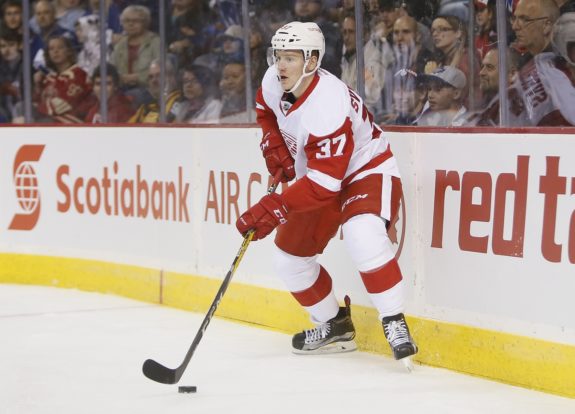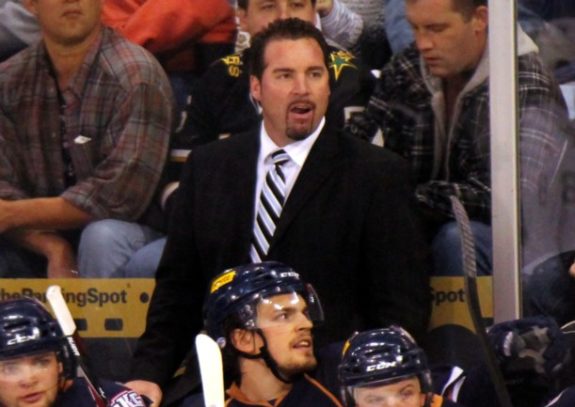As the 2017-18 season winds down, the Detroit Red Wings have the opportunity to prepare for next year with their season essentially over. Playoffs are still possible—the team certainly knows that—but a return to the postseason is unlikely.
Next year’s team will feature 2015 first-round pick, Evgeny Svechnikov, in a top-nine role. After a brief cameo last season, the winger was granted another audition in the waning weeks following Frans Nielsen’s injury. Svechnikov earned the call-up after he was able to shake off a brutal first-half of the season and kick his game into full gear with the Grand Rapids Griffins.

Though the young forward is now with the Red Wings, his ice time has come into question. Through his first few games, Svechnikov has yet to crack ten minutes of all-situations play in any contest. Should the highly-touted prospect be receiving more ice time on a team with mistake-prone veterans?
The answer is simple: Be patient. He’ll get the ice time he deserves.
Related: Red Wings Pipeline Notes: 7 Promising Prospects
Setting Expectations
With Anthony Mantha and Dylan Larkin stepping into high-impact roles and other young players like Andreas Athanasiou and Tyler Bertuzzi becoming more consistent contributors, it’s easy to see why we’re excited about the latest prospect to join the Red Wings. However, those players also had to earn their time.
Larkin started his rookie year on a line with Henrik Zetterberg and Justin Abdelkader and never looked back. He was the most NHL-ready prospect of the bunch. The others, though, earned their ice time in similar fashion to Svechnikov. Just take a look at their all-situations ice time during their first taste of NHL action:
| Player | Campaign | GP | TOI |
| Anthony Mantha | 2015-16 | 10 | 11:42 |
| Andreas Athanasiou | 2015-16 | 37 | 9:01 |
| Tyler Bertuzzi | 2016-17 | 7 | 9:06 |
| Evgeny Svechnikov | 2017-18 | 4 | 7:48 |
Despite Athanasiou’s impressive rookie season (9 goals, 14 points), he was not automatically anointed top-six minutes. He—like the others—had to prove he could play at both ends of the ice before moving up the depth chart. Even Pavel Datsyuk had to pay his dues before stepping into a larger role – the Magic Man played the eighth-most all-situations minutes among forwards during his rookie season. Svechnikov will be no different; these lessons take time to fully grasp.
Svechnikov is Still Learning
There may be the demand to play Svechnikov more but the Red Wings would be wise to let him get his feet wet before throwing the rookie into the deep-end. The added learning time will benefit both parties in the long run. It’s no secret that he struggled in the AHL earlier this season. His preseason injury contributed to the slump but he was the main cause of his struggles.
Griffins coach Todd Nelson shared his analysis with MLive’s Pete Wallner back in December as Svechnikov began to show signs of life: “His problem is he’s his own worst critic. Sometimes, he puts a lot of pressure on himself and when that happens, things go in a bad way.”

If a young player struggles with putting too much pressure on himself to get acclimated, why put him back in the same situation?
The NHL is faster than any other league in terms of the speed in which players dart around the ice, in which decisions are made, passes are launched, and mistakes are exploited. It would benefit Svechnikov to adjust to the NHL speed through calculated zone starts and with time to watch how the game is played. Playing the rookie against top players is too much too soon. Remember: he’s only 21 and has plenty of games ahead of him.
Give Svechnikov time to adjust to the pace of the NHL with sheltered minutes. Then, once he’s acclimated to the speed, he’ll begin to play more and be given time to round out his game. Only then will he earn the minutes typically given to someone of his pedigree. This plan of attack will lead to the greatest success for both the team and player; it’s worked for Athanasiou, Bertuzzi, and Mantha so far.